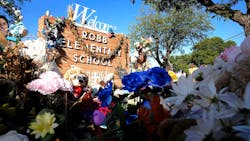More scrutiny of school security officers with Uvalde indictments
Just over a year after a former school deputy was acquitted of neglect charges in the Parkland, Fla. mass shooting, two security officials at the center of the botched law enforcement response in the Uvalde, Texas massacre have been indicted.
A Uvalde County grand jury recently indicted Pete Arredondo, the former Uvalde County Intermediate School District (UCISD) police chief and incident commander during the mass shooting, on 10 counts of abandoning or endangering a child.
The indictment alleged Arredondo “by act and omission, intentionally, knowingly, recklessly and with criminal negligence,” placed the Robb Elementary School children in “imminent danger of injury, death, physical impairment and mental impairment.”
Adrian Gonzales, a peace officer for UCISD, was charged with 29 counts of abandoning or endangering a child. The indictment alleges that after hearing gunshots and having adequate time to respond, he “failed to engage, distract or delay the shooter” or attempt to do so until after the suspect entered rooms 111 and 112 and started shooting.
In the case against Aredondo, prosecutors say that after hearing shots being fired in a room at the elementary school, Arredondo failed to identify the incident as an active shooter incident, failed to respond as trained to an active shooter incident, and instead called for a SWAT team, delaying law enforcement response to the shooter “who was hunting and shooting a child or children in Room 112” of the school.
The indictment said Arredondo had been advised that both a teacher and a child or children had been injured but still didn’t respond according to his training, but “instead directed law enforcement to “evacuate the wing before confronting the shooter,” which delayed response.
The grand jury also accuses Arredondo of failing to enforce an active shooter response plan developed by the ISD by evacuating students before stopping an active shooter and failing to follow his training by “deciding and declaring to others to delay breaching a room occupied by a gunman” until classrooms were evacuated.
Additionally, the indictment says Arredondo tried to negotiate with the gunman in Rooms 111 and 112. At the same time, the suspect was engaged as an active shooter, failed to determine if a door to classroom 111 was locked, and failed to provide keys and breaching tools to enter classrooms promptly – all of which delayed law enforcement response.
Arredondo had also failed, the indictment alleges, to follow district policy by establishing a command center and directing others to do the same, “thereby leaving law enforcement officers and Border Patrol agents without clear information or direction regarding the active shooter incident…” the indictment alleged.
Arredondo also failed to “develop an immediate action plan” or to direct others to do so and communicate to them an immediate action plan to respond to the gunman if the shooting began again.
Gonzalez, according to the indictment, also failed to follow or attempt to follow active shooter training to respond to gunfire by advancing toward the gunfire until after the suspect shot at one or more of the children.
Familiar Territory
Scot Peterson was a Broward County Sheriff’s Office member who had received many hours of training in the proper response to an active shooter situation and received additional training as a School Resource Officer.
Peterson faced seven counts of child neglect, with the state alleging Peterson was in the position of “caregiver” of the children at the school, which made his reported failure to protect the children – via neglect – a felony under Florida law.
He was also charged with three counts of misdemeanor “culpable negligence,” where he exhibited “a reckless indifference to or grossly careless disregard for others,” exposing adults on the third floor of the building to personal injury.
The Uvalde indictments followed two scathing reports issued by the U.S. Department of Justice and Texas Department of Public Safety.
The DOJ report found that chaos pervaded the police response to the massacre, resulting in unnecessary delays and confusion over whether the gunman was an "active shooter."
With no one taking the role of on-scene commander, worsening a cascade of poor decisions, a team of law enforcement officers didn’t confront and kill the shooter until 77 minutes into his rampage.
Enough officers were on hand to take out the gunman soon after he entered the school and riddled two classrooms with semiautomatic gunfire, killing 19 students and two teachers and injuring 17 others — but they faltered, DOJ investigators said in their 575-page report
UCISD officials declined to comment on the indictments, stating they had only recently learned about the grand jury’s decision and administrators had nothing else to add.
“As we have done and continue to do, we extend our sincerest sympathies to all who lost loved ones. Our hearts go out to everyone affected by this challenging situation,” said Anne Espinoza, Executive Director of Communications for the district.
More Scrutiny Coming?
Peterson was aware that active shooter Nicholas Cruz was inside the 1200 building at Marjory Stoneman Douglas High School and, prosecutors said, willfully failed to act pursuant to his law enforcement training and sworn duties to promptly address the active shooter -- instead, retreating to a position of increased personal safety.
Peterson failed to make a reasonable effort “as a caregiver” to protect the children “from abuse, neglect or exploitation” by failing or refusing to investigate the source of the gunshots, fleeing the area, and not engaging or confronting the gunman, prosecutors alleged.
To be sure, Peterson’s charges were not a total surprise. However, they did cast school security officials in an unprecedented light, suggesting they were legally culpable for the students' care.
In the Uvalde County case, Arredondo and Gonzalez are similarly faulted for not immediately taking action to confront the shooter in a school building.
Ken Trump, a school safety, security and emergency-crisis consultant and president of National School Safety and Security Services, acknowledges school security and police officers will face a great deal of scrutiny if a high-profile school shooting or other violent act occurs.
Increasingly these questions are moving from the schoolhouse to the courthouse in civil litigation, he says, as criminal charges of police officers in the Parkland and Uvalde cases have come following intense pressure from their communities and media attention for their actions and inactions.
“Moral, ethical, and operational issues around their responses typically raise many emotions, anger and feelings of disgrace,” Trump says. “When the cases hit the courtroom, however, case law precedent may very well not result in their convictions from a criminal perspective. Civil litigation, however, could present a different liability outcome depending upon the facts of the case.”
Guy Grace, K-12 National Security Program Manager for ASSA-ABLOY and Vice Chairman for the Partner Alliance for Safer Schools says his focus has been on working with organizations and schools on best practices to reduce such events from happening. Grace says he recently attended a school safety conference in Texas and was impressed with the steps school districts take to reduce risk.
“It’s clear to me that school districts face safety and security challenges that are multifaceted and complex and they must be prepared to address a full range of situations that pose risks to students and staff, including everyday emergencies like disturbances, medical emergencies, weather, and community emergencies, to name a few,” says Grace, who has been a school security professional for more than 38 years and has experience responding as part of a team to different kinds of emergencies and situations.
“We often do not hear about these day-to-day emergencies and if they are not properly responded to and managed, they can be very problematic to the schools and become dangerous situations. We have also responded to some very serious and life-changing events that are typically described as “active threats” or active shooter events.
“No single action will, by itself, make our schools safe. Protecting students and staff is a tremendous moral and legal responsibility that requires a comprehensive approach to these challenges.
“I took the position at ASSA ABLOY because I believe in access control and technology. I also believe in human roles and processes and interventions,” says Grace, who has been a school security professional for more than 38 years and has experience responding with fellow safety professionals to different kinds of emergencies and situations.
“If the schools and communities do the right things, it is more likely we won’t see people hurt and people facing repercussions for what happened.”
About the Author
John Dobberstein
Managing Editor/SecurityInfoWatch.com
John Dobberstein is managing editor of SecurityInfoWatch.com and oversees all content creation for the website. Dobberstein continues a 34-year decorated journalism career that has included stops at a variety of newspapers and B2B magazines. He most recently served as senior editor for the Endeavor Business Media magazine Utility Products.

